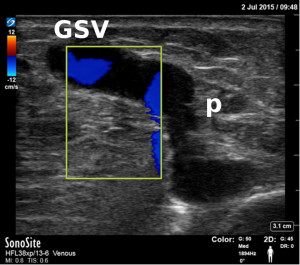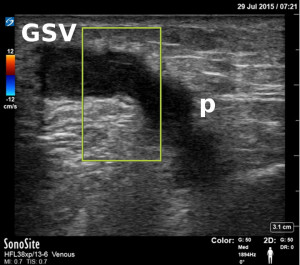MOCA is an abbreviation for mechano-chemical ablation. It is the combination of a rotating metal filament used to denude the venous endothelium and put the vein into spasm. Concomitant instillation of liquid sclerosant ensures venous destruction. The application device is inserted percutaneously, under ultrasound control, into the vein awaiting ablation and advanced proximally. The saphenous trunks are usually the target but straight tributaries may be treated also using the device. It is not suitable for tortuous varicose veins. Mechanical ablation occurs concurrently with chemical ablation as the catheter is withdrawn slowly.
NICHOLAS R F LAGATTOLLA Endovenous ablation with MOCA requires only a single ultrasound-guided puncture under local anaesthesia. This results in instant venous closure which is permanent in 97% of cases. This is an equivalent closure rate to endothermal techniques like endovenous laser ablation (EVLA) and radiofrequency ablation (RFA). The procedure is well tolerated and painless with only a sensation of vibration from the rotating arm. The main benefit over the endothermal techniques is that tumescence is not required. This shortens the procedure time and reduces procedural pain because tumescence requires injections of anaesthetic volume to surround the target vein. Furthermore, there is no potential for nerve injury because the treatment does not act by thermal destruction which may be conducted to surrounding tissues, including nerves. Whilst ultrasound guided foam sclerotherapy (UGFS) has many of the advantages of MOCA, the ablation rates are not as good with USGF alone, particularly in large veins. MOCA thus reduces the likelihood of additional treatments.
We have treated many refluxing saphenous trunks using MOCA. Several patients had venous ulcers which improve after treatment. The technique was particularly good for patients with thin aged skin and superficial veins because these are always at risk of skin burns with the endothermal techniques. As with all the techniques the complication rates are miniscule in experienced hands.
MOCA is an effective and relatively atraumatic method to ablate refluxing venous trunks in limbs that may not be optimal for tumescent anaesthesia and endothermal ablation.
Pre-procedural vascular ultrasound of a wide patent incompetent below-knee (Boyd’s) perforating vein (p) entering the greater saphenous vein (GSV) and rendering it incompetent below. The colour flow demonstrates luminal patency.
Vascular ultrasound performed at four weeks demonstrating echogenic occlusion of both the perforating (p) and the greater saphenous vein (GSV), and no flow demonstrable on colour flow imaging after calf compression. The perforating vein closed despite the fact it did not receive direct treatment.

